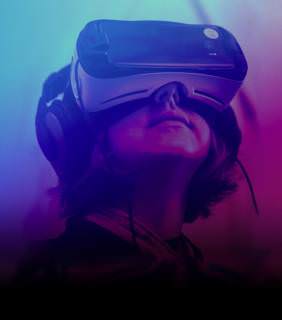Technology Experience, a.k.a. TechX, is new to Advertising Week this year. The gallery experience, presented by VentureFuel and Experiential Advertising Group, is located at the heart of Times Square and showcases some of the biggest technological innovations that advertisers and marketers should be keeping an eye on, including virtual and augmented reality, artificial intelligence and holograms.

VNTANA is showing a life-sized hologram projector at the event, and with it, attendees can interact with characters, sports celebrities or speak to someone via a livestream as though they were in the room. The potential for this kind of location-based technology becomes even more apparent when seen alongside innovations in artificial intelligence that respond to people’s verbal responses, or seemingly straightforward technologies, like targeted speakers that can cut through environmental noise so that users can clearly hear content even when in a crowd, or amid noisy traffic at a bus stop.
“Categories such as VR, AR, MR and AI are rapidly growing,” Allie Feinstein, director of innovation and brand strategy at VentureFuel, told AListDaily. “Advertising is becoming more personalized, allowing advertisers to truly connect one-to-one. Whether that be through an immersive, engaging augmented reality experience, as illustrated by companies like Guru or 8i, or with AI, companies like Throtle and IRIS.TV, that leverage data to better understand the consumer and connect with them in a relevant manner.”
Video game developer DreamSail was at the TechX showcase to demonstrate Iota, its upcoming mechanized robot game where players blast giant bots, drones and destroy buildings in VR. The developer was also showing a greenscreen cube, where users could place themselves into virtual worlds for livestreams and other content—essentially combining virtual and augmented reality.
Feinstein thinks mass adoption for AR may be coming soon, especially with Apple, Google, and Facebook backing it.
“We’re already used to throwing up rainbows or donning puppy dog ears [on social media],” she said. “ARKit, ARCore and AR Studio will only further open up the window of opportunity to develop more content, which promises to engage consumers and, in turn, brands.”
But even with AR seemingly on the rise, VR still has a prominent standing among brands, especially in the movie industry. The only question is whether they should develop experiences for pricey premium headsets such as the Oculus Rift and HTC Vive, or focus on the accessibility of mobile devices like the Samsung Gear VR.
“It depends on the strategy,” said Feinstein, who explained VR experiences can be powerful and meaningful in an event setting and mobile VR—broadly including 360 video—lends itself to more reach. “With consumer adoption of VR headsets being slower than expected, brands are more hesitant to invest in content creation for experiences that require a headset, however, it really depends on the story they are trying to tell. The bigger opportunity at the moment will likely be mobile AR.”
On that topic, mobile AR experiences that placed users next to exotic animals such as tigers for videos and photos can be seen at TechX alongside the VNTANA hologram projector, which begs comparison. Although the hologram projector is impressive, with users able to throw virtual tennis balls for athletes like Roger Federer to hit, it is limited to location-based experiences. Similar to VR, marketers may have to balance between the impact of a physical event and the accessibility of a digital campaign.

“It’s interesting that we’ve seen growth of digital in tandem with physical experience,” said Feinstein. “Experience is the currency of the younger generation, but if it isn’t shared, it’s like it didn’t happen. So, I don’t think it’s about digital vs. physical, but instead technology evolving the entire consumer journey and brands embracing these trends to stay relevant.”
Although Iota was the only actual video game at TechX, it’s hard to overlook how technology is increasingly blurring the line between marketing and games. Feinstein shared her thoughts on the defining line by stating that it all comes back to relevance.
“There has to be a relevant connection between the experience and what the brand is trying to say,” she explained. “Say you’re playing a mech game from DreamSail, as giant robot walking through the city. You may spot a Coca-Cola billboard on the street as you might in real life and maybe there’s a gamification element where Coke fuels your robot. It’s all about story, context and relevance.”
Feinstein also said that word-of-mouth is the best form of advertising because it’s relevant and authentic. “When your friend recommends a product, you don’t consider it advertising. In the same way, advertising as content is powerful when it’s relevant and authentic,” said Feinstein.
All the technologies shown at TechX are evolving and iterating on a daily basis, Feinstein said.
“Brands need to stay on top of all of the different ways they can create experiences, make their messaging more personalized and be more efficient,” said Feinstein. “It can be overwhelming, which is why VentureFuel is dedicated to custom technology solutions for brands and agencies.”

